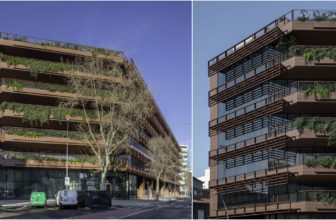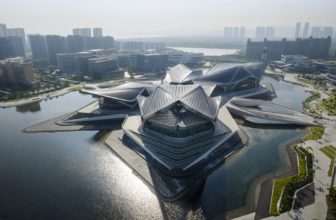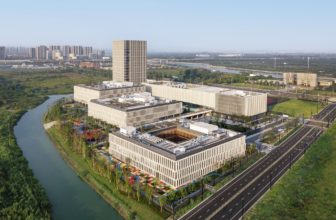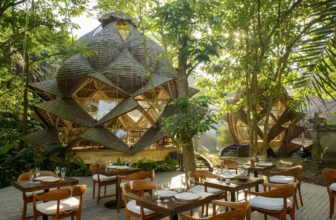Microtherm
Tranquility is beauty validated and accentuated by comfort. Discomposure is beauty drained by lack of it. The firm, Matter Design – an interdisciplinary design practice founded in 2008 by Clifford and Wes McGee-has harnessed the sensitive relationship between thermal and sensorial experiences that produces contradictions of conventional notions of comfort. The Microtherme installation, contingent on the conception of the Roman bath complex, is on view in the Atlantic Wharf building, which sits adjacent to the headquarters for the Boston Society of Architects (BSA).  The BSA-curated exhibition ‘Bigger Than a Breadbox, Smaller Than a Building’ stood host to the ingenious Matter Design structure. An unconventional spell on a traditional sauna, this new installation by Boston-based architecture studio Matter Design debuts a wooden box measuring seven feet long, eight feet wide and seven feet high (2.1 metres by 2.4 metres by 2.1 metres).
The BSA-curated exhibition ‘Bigger Than a Breadbox, Smaller Than a Building’ stood host to the ingenious Matter Design structure. An unconventional spell on a traditional sauna, this new installation by Boston-based architecture studio Matter Design debuts a wooden box measuring seven feet long, eight feet wide and seven feet high (2.1 metres by 2.4 metres by 2.1 metres).  Suspended from the ceiling by a beam, the ‘condensed concrete spa’ conceals sculptural interior walls as 6 distinct panels which emanate different temperatures, engendering an “intimate and contradictory set of experiences”. Comfort seeking enthusiasts are required to approach the two holes in the bottom of the box, by laying down down and rolling under the space. The holes, a single hole on the side of the box along with two holes on the bottom, have been cleverly devised precisely of anthropometric caliber.
Suspended from the ceiling by a beam, the ‘condensed concrete spa’ conceals sculptural interior walls as 6 distinct panels which emanate different temperatures, engendering an “intimate and contradictory set of experiences”. Comfort seeking enthusiasts are required to approach the two holes in the bottom of the box, by laying down down and rolling under the space. The holes, a single hole on the side of the box along with two holes on the bottom, have been cleverly devised precisely of anthropometric caliber.  Escorting the occupants from one extremity to another, where the upper portion produces a heat level one might feel while sunbathing, and the lower section is cold and is meant to evoke the feeling of swimming in a concrete bath – Microtherme guarantees thermal delight. The studio produced the voluptuous forms by using a machined mould made of expanded polystyrene (EPS) foam coated in a water-based surfacing compound. The mold is cast spraying Glass Fiber Reinforced Concrete (GFRC) with a lining of copper tubing to allow warm and cool water to pass through in order to control the temperature of the concrete. Copper tubes placed behind the walls enable hot and cool water to circulate through the structure. The installation is on view until 4 October 2015.
Escorting the occupants from one extremity to another, where the upper portion produces a heat level one might feel while sunbathing, and the lower section is cold and is meant to evoke the feeling of swimming in a concrete bath – Microtherme guarantees thermal delight. The studio produced the voluptuous forms by using a machined mould made of expanded polystyrene (EPS) foam coated in a water-based surfacing compound. The mold is cast spraying Glass Fiber Reinforced Concrete (GFRC) with a lining of copper tubing to allow warm and cool water to pass through in order to control the temperature of the concrete. Copper tubes placed behind the walls enable hot and cool water to circulate through the structure. The installation is on view until 4 October 2015.  By: Aleeshba Saigol.
By: Aleeshba Saigol.





